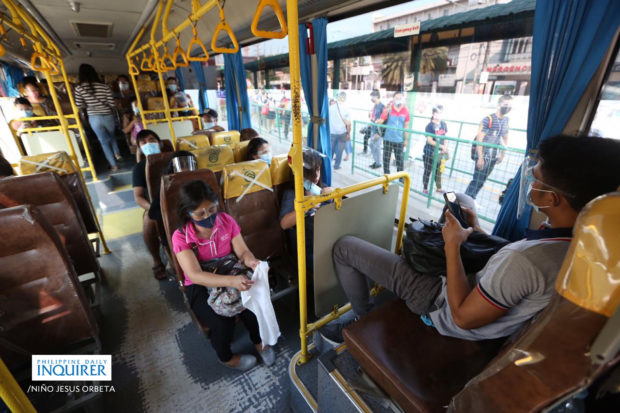Gov’t mulls reducing one-meter distancing in public transport anew
MANILA, Philippines — The government will once again reconsider reducing the one-meter physical distancing policy among passengers of public utility vehicles (PUVs) as it sets its sights on further reopening the COVID-19 pandemic-hit economy.
According to Cabinet Secretary Karlo Nograles, co-chair of the Inter-Agency Task Force on Emerging Infectious Diseases (IATF), public transportation capacity must be increased to help people go back to their jobs.
“We have to engage again the health sector, the doctors in again reconsidering itong (physical) distancing, only to increase capacity in public transportation,” Nograles told INQUIRER.net in an online interview Wednesday.
He noted that the move is in line with the implementation of the government’s National Action Plan Phase 3, which shifts more to reopening the economy while managing the risk of the coronavirus disease.

Passengers line up to board Edsa Carousel buses at Monumento, Caloocan City on September 30, 2020. Niño Jesus Orbeta/Philippine Daily Inquirer
The IATF earlier approved the proposal to reduce physical distancing inside PUVs to 0.75 meters from one meter. But some medical experts warned that reducing the prescribed physical distance among commuters may lead to further COVID-19 transmission.
Article continues after this advertisementThe opposition prompted President Rodrigo Duterte to reject the new protocol and maintain the World Health Organization-recommended one-meter physical distance rule.
Article continues after this advertisementNograles argued that the health sector only opposed the proposal as they were not comfortable with the country’s epidemiological status then.
With the epidemiological indicators going down, he said that health experts may now agree to the reduced physical distancing policy.
“Noong nag-oppose ‘yung mga doctors, it was a time na medyo hindi pa sila kampante kasi they were not comfortable with the numbers. ‘Yung positivity rate, yung R-naught score natin, attack rate, and all these epidemiological indicators natin,” Nograles said.
“But right now, it appears that these indicators are going down. R naught is going down, positivity rate is going down, the attack rate is going down, the transmission rate is going down so maybe now is the right time to start talking about this thing,” he added.
He went on: “Also because going on Phase 3 of our National Action Plan. We have to start catching up already, we are in the 4th quarter of 2020, magtatransition na tayo sa 1st quarter ng 2021. And remember it was in 2021 na umaasa tayo na magbo-bounceback ang ating economy… so this is the right time.”
The government earlier allowed several businesses in areas under general community quarantine (GCQ) like Metro Manila to operate at full capacity.
This was followed by an appeal by Labor Secretary Silvestre Bello III, who called for an increase of up to 70 percent in the capacity of public transportation to help people get to their place of work.
EDV
For more news about the novel coronavirus click here.
What you need to know about Coronavirus.
For more information on COVID-19, call the DOH Hotline: (02) 86517800 local 1149/1150.
The Inquirer Foundation supports our healthcare frontliners and is still accepting cash donations to be deposited at Banco de Oro (BDO) current account #007960018860 or donate through PayMaya using this link.